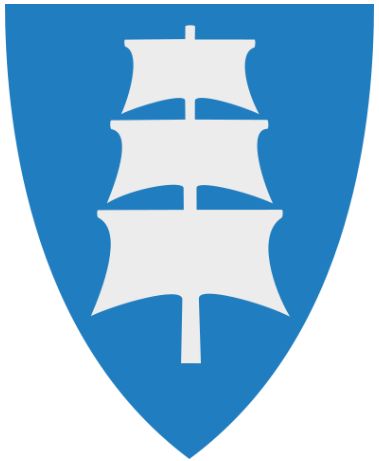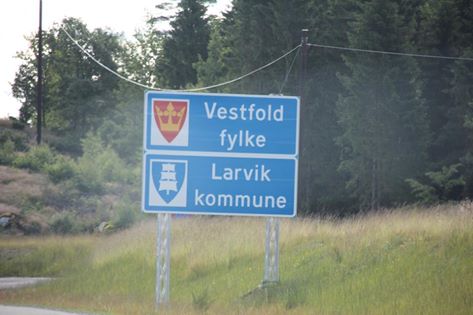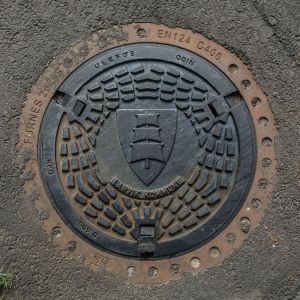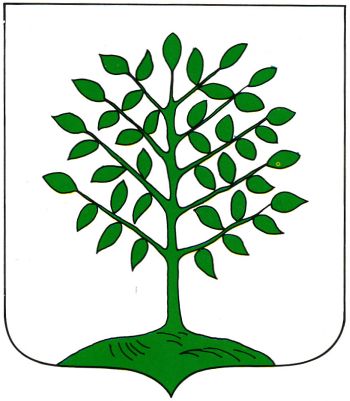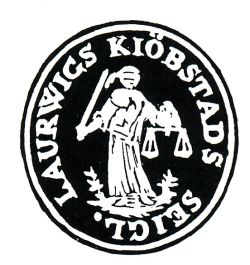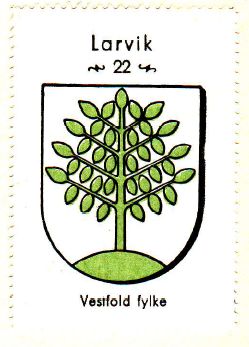Larvik: Difference between revisions
Knorrepoes (talk | contribs) m (Text replacement - "Hugo Gerhard Ströhl" to "Hugo Gerard Ströhl") |
Knorrepoes (talk | contribs) No edit summary |
||
| Line 29: | Line 29: | ||
The arms how a mast with three sails to represent the maritime traditions of the municipality. | The arms how a mast with three sails to represent the maritime traditions of the municipality. | ||
{|align="center" | |||
|align="center"|[[File:larvik3.jpg|center]] <br/>The arms at the municipal border (image by Jan-Erik Løken) | |||
|align="center"|[[File:{{PAGENAME}}7.jpg|center|300 px|Arms of {{PAGENAME}}]] <br/>The arms on a manhole cover | |||
|} | |||
The oldest arms from 1899 : | The oldest arms from 1899 : | ||
[[File:larvik.jpg|center]] | [[File:larvik.jpg|center|Arms of {{PAGENAME}}]] | ||
These arms are known since 1899 and show an unidentified tree. The tree probably symbolises the beech forest around the town. A (beech) tree has been used by the 18<sup>th</sup> century governor of the area, Jens Kielman, as well as in a seal of a local guild in the early 19<sup>th</sup> century. | These arms are known since 1899 and show an unidentified tree. The tree probably symbolises the beech forest around the town. A (beech) tree has been used by the 18<sup>th</sup> century governor of the area, Jens Kielman, as well as in a seal of a local guild in the early 19<sup>th</sup> century. | ||
| Line 41: | Line 46: | ||
|align="center"|[[File:larvik.hagno.jpg|center|Arms of {{PAGENAME}}]] <br/>The arms in the [[Kaffe Hag Norge|Coffee Hag album]] +/- 1930 | |align="center"|[[File:larvik.hagno.jpg|center|Arms of {{PAGENAME}}]] <br/>The arms in the [[Kaffe Hag Norge|Coffee Hag album]] +/- 1930 | ||
|} | |} | ||
{{media}} | {{media}} | ||
Revision as of 04:41, 28 August 2021
| Heraldry of the World Verdens heraldikk |
| Norwegian heraldry portal Norsk Heraldik |
|
LARVIK
Province : Vestfold og Telemark (until 2020 Vestfold)
Additions : 1988 Brunlanes, Hedrum, Stavern, Tjølling; 2018 Lardal
Official blazon
- (2018) I blått et oppvoksende tre med syv dråpeformede blader hvor av seks er motstående to og to, alt i sølv.
- (1989) På blå botn ei sølv mast med tre segl.
Origin/meaning
The current arms were adopted in 2018.
The arms show seven sources of water forming a tree.
The seven drops symbolize forest water flowing out into streams (for example the Lågen and Farris rivers), and further into the river that ends in the fjord. Moving water has formed the basis for ironworks, industry, salmon fishing and clean energy production. They drops also symbolise the safe harbours in the municipality.
The drops also symbolize the six former municipalities. The drops finally symbolise clean and fresh water.
The tree symbolizes the forests, where forestry has been of great importance for growth and business activity. The tree also symbolizes the beech forest, as well as the importance of the forest as a well-being factor and recreation source.
The previous arms were granted on ??-??-1989.
The arms how a mast with three sails to represent the maritime traditions of the municipality.
| The arms at the municipal border (image by Jan-Erik Løken) |
The arms on a manhole cover |
The oldest arms from 1899 :
These arms are known since 1899 and show an unidentified tree. The tree probably symbolises the beech forest around the town. A (beech) tree has been used by the 18th century governor of the area, Jens Kielman, as well as in a seal of a local guild in the early 19th century.
| The seal of Larvik from 1825 |
The arms by Ströhl in 1905. |
| The arms in the Coffee Hag album +/- 1930 |
Contact and Support
Partners:
Your logo here ?
Contact us
© since 1995, Heraldry of the World, Ralf Hartemink 
Index of the site
Literature : Norwegian Municipal Network; Norske Kommunevåpen, Kommunalforlaget, 1987. Capellen, 1987




